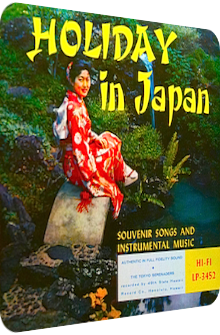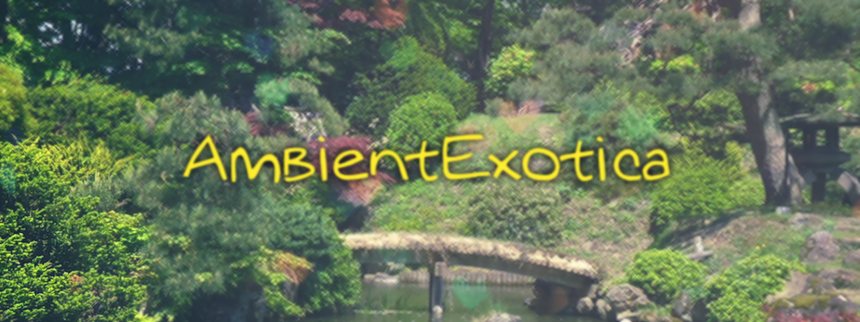
Tokyo Serenaders
Holiday In Japan
1950's
Many websites tell the story about the record label behind the releases of the Tokyo Serenaders, an ephemeral group of unknown session musicians whose album Holiday In Japan I'm about to review, but no blog or forum talks in greater detail about the peculiarities of them. Let me provide them for you and recapture the common knowledge about the so-called 49th State Hawaii Records. Founded in, well, Hawaii by George Ching in the early 50's, the label owner anticipated Hawaii to be the official 49th US state some time in the future, as it was common gossip back then. This time came in August 1959, but it just so happened that Alaska had been given number 49 prior to Hawaii. Regardless of this incident, the title of the label can be indeed considered a clever marketing scheme. Ching wanted to target tourists of all kinds with his label's output as well as truly interested music lovers.
That's where a highly interesting distinction comes into play: on the front artwork of every LP by the label, there's a highlighted marker whether a particular album is specifically made for tourists or for the connoisseur. Holiday In Japan is linked to the former description due to the classification as "souvenir songs"; an error, I believe, for the 12 tracks – six of them vocal songs, the other six instrumentals – sound very real, humble and encompass a typical Japanese aura without falling prey to kitschy and syrupy tone sequences. Since the release dates are never printed on the back sleeves, I'm not sure when this particular record was released. It must have been in the 50's, when tourism rose and the general interest in Hawaii built up even before the Exotica and tiki craze.
I don't want to overanalyze the release or view it through rose-tinted glasses, but it's also worth mentioning that Holiday In Japan not only served as a device to fend off the yearning of tourists, but also an understanding mediating pop artifact among Japan and the United States. As such, the faux-factor that is usually attached to the Exotica genre is nowhere to be found on here. Thankfully, the LP is now available in a remastered version as a digital download, but more about this below. Let's see whether Holiday In Japan is of value to the Exotica fan.
Side A is definitely the more interesting side of the LP, and then it is probably not, for it comprises of six vocal tracks, an often neglected addendum of the Exotica genre. The success of this side thus depends on the personal taste of the listener. If the voices are despised, the tracks are pretty much worthless. Nagasaki Mono-Gatari (= the history of Nagasaki), arranged by Sparky Iwamoto, assures the listener of being a proper Japanese recording. Despite the fact that tourists are the clear target of this record, it's by no means kitschy. Sure, this opening track launches with a few temple gong beats, but the whirring wind chimes are already extraordinarily suave and soothing. New Age wasn't invented back then, so the record isn't spoiled by such allusions. A galloping rhythm, an accentuating alto flute melody plus double bass backings provide the earthen background for the female soprano lead singer to shine. It's a traditional Japanese track – as all the included songs are – and thus provides a seriously humble and real listening experience.
Suite Ita Noni is a vibraphone-heavy, flute-accompanied downbeat piece with a male singer whose voice is a bit whiney, with too much vibrato in it. Traditional songs with vocals stand and fall with the quality of the voices, and the song fails in this regard, but on the plus side resides once again the astonishing aura of realism and grace that's further nurtured by the vibraphones. Even if this record was solely created to cash in does the quality impress.
While the upbeat Samisen Madorusu (madorusu = sailor) adds a quickly slapped samisen/shamisen, i.e. a Japanese three-stringed banjo to the pool of instruments used on this record and relies once more on the female voice, the typical tick-tock rhythm and scattered glitters without offering much else, the much more interesting Yuuraku-Cho De Aimasho is a doleful track with a bolder European tonality attached thanks to the lamenting solo trumpet and that unnamed singer of the second song. Even the string instrument, possibly the shamisen, mimicks a Sicilian jaw harp, all the while the singer continues to sing in Japanese. What a positively weird twist! The following Sendo Kawai-Ya is a favorite of mine, capturing the kitschy mood of Japan thanks to clinging tambourins and a silky interplay between two alto flutes and various vibraphone droplets. The lady is providing the vocals one last time. The same goes for the male singer whose performance on Wakare No Ippon-Sugi is again melodramatic and gloomy, the flutes tremble in minor and the vibraphones lose their glinting nature altogether.
Whereas side A featured vocal tracks, side B goes all in on the instrumental side, and this is where things become intriguing for Exotica listeners who are a bit bewildered by the truthful aura of Japanese Folk music hat is loaded with vocals. Nagasaki lets the listener hear the same instruments as before, but since no vocals detract from the setting, One can worship them even more. A noteworthy inclusion is the solo violin, a clarinet and a wonderful short solo of glistening vibraphone dew. The tambourins are shaken while the setting shuffles between a mystical solemnity and more cheerful tone sequences. Yie Lai Shan opens with clicking claves, wind chimes, tambourins and chirping birds! It soon morphs into the most glaring jazzy tune, though. A bass flute and a trombone interact, somehow destroying the splendidly exotic opening section, but luckily enough, the percussion is maintained throughout the tune, adding a nice feeling of space to it.
While So-Ma Bon Uta (uta means ditty) presents a colorful Japanese march that is based on a superb rhythm and rounded off with warped flutes, shamisen accompaniments and clicking woodsticks, Samisen Mambo is the cheerful song on this LP that actually lives up to its name – even more so since it is one of the few track titles I can, ahem, fully understand. The hollow wood blocks and drums add plasticity, I even spot a ukulele in the background. The shamisen is in the limelight, as expected, and plays an almost Western melody. Tak Shindo's Far East Goes Western comes to mind, and this song would have fitted very well on that album. The penultimate Akogare Wa Basha Ni Notte injects the joyful warmth of Japan into the ears of the listener, with tick-tocking clicks, a mellow clarinet, vivid shamisen twangs and tambourins that really evoke the Jingle Bells skit on more than one occasion.
The final Dahil Sayo is an unexpected treat, as it is also featured on Arthur Lyman's second album and first Exotica release called Taboo (1958). The vibraphones are completely missing here, but the jaw harp-evoking shamisen riffs, brazen trumpets and profound bass flutes keep the jazzy flavor high. The melody is top notch and even hummable. A great way to end an entirely overlooked dob of the genre.
Holiday In Japan is a successful album. Sure, it's ephemeral, the singers and instrumentalists interchangeable, but the performed material is not only catchy and positively strange, but definitely beautiful in its best moments. You wouldn't expect this due to the yellow marker on the front cover that advertises this record as a perfect souvenir for tourists. I don't disagree with this statement, it's just that many an Exotica release I've written about would be better suited in this category than this LP. It's a good idea, both aesthetically and conceptually, to divide the vocal and instrumental tracks, as an intermixture would have been nerve-wrecking to many contemporary ears. Label owner George Ching chose the topos and the talents wisely, and the humble appearance of the Toyko Serenaders helps the good, money-unrelated spirits of their LP. I don't make this remark to stress a spiritual zen way rather than to point out a metaphorical sense: this music is real and it serves a real purpose, namely that of a semi-cultural, semi-popular artifact of mediation between the United States and Japan. That the touristic flavor doesn't permeate even one single song is astonishing.
It's an LP I recommend highly for its novelty factor in terms of Exotica. Sure enough, 49th State Records continued to release similar albums, and there are shedloads of Japanese albums out there which are produced in that fashion even to this day, but the interesting story behind the label as well as the inclusion of exotic instruments make this a valuable entry which has, as I've stated in the opening paragraph, recently been remastered and re-released. Since I don't know much else about the other offerings, I'm very intrigued to purchase and review further releases once the time is right. Recommended for Exotica listeners who want to get hold of an exotic album, even by Exotica standards.
Further reading:
In a collaborative effort, Cord International and Hana Ola Records have remastered all of the records originally released on the 49th State Hawaii label. Read more about its history and the offered selection on the website of Cord International here – it really is an intriguing archive.
Exotica Review 104: Tokyo Serenaders – Holiday In Japan (1950's). Originally published on Aug. 11, 2012 at AmbientExotica.com.
